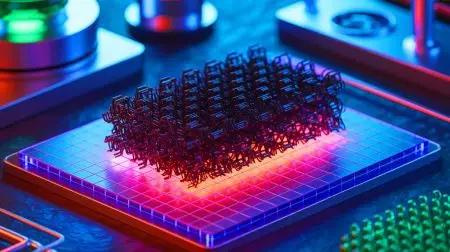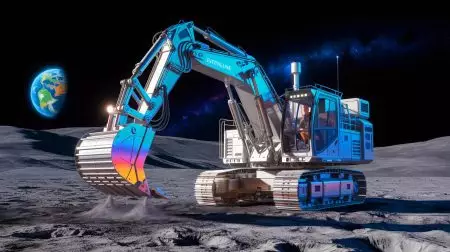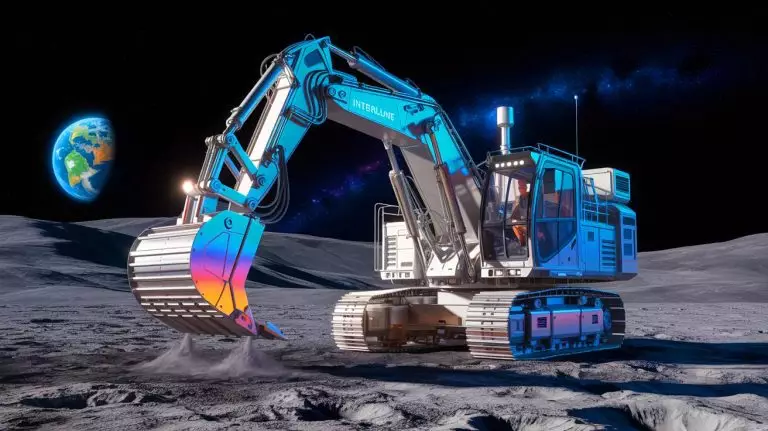| IN A NUTSHELL |
|
With the race to harness clean energy intensifying, the prospect of utilizing helium-3 from the moon presents a tantalizing opportunity. This rare isotope could be the key to revolutionizing both energy production and quantum computing. A pioneering company, Interlune, is taking bold steps to extract helium-3 from lunar soil and transport it back to Earth. Their groundbreaking work could lead to significant advancements in technology and energy, setting the stage for a new era of innovation. Let’s delve deeper into how Interlune’s ambitious plans could transform our future.
The Working Mechanism of Interlune’s Lunar Excavator
Helium-3 (He-3), a non-radioactive isotope of helium, is exceptionally scarce on Earth but relatively plentiful on the moon. Over billions of years, solar winds have bombarded the lunar surface, embedding helium-3 into the moon’s soil. Interlune has engineered a prototype excavator designed to extract this precious gas. This advanced machine can dig up to ten feet into the moon’s surface, accessing regions where helium-3 concentration is higher.
The excavator processes up to 110 tons of lunar soil per hour and employs a specialized gaseous chemical method to separate helium-3 from other elements within the lunar environment. Importantly, Interlune plans to refine the gas directly on the moon, shipping only the helium-3 back to Earth. This approach not only enhances efficiency but also reduces costs significantly. The collaboration with Vermeer, renowned for industrial excavation equipment, underscores the project’s innovative nature. The prototype is undergoing rigorous testing on Earth to simulate lunar conditions, ensuring its operational success when deployed.
Helium-3 Promises a Hi-Tech Future
Helium-3 is poised to be a game-changer in the field of nuclear fusion, offering a pathway to clean energy with minimal radioactive waste. Unlike conventional nuclear reactions, fusion using helium-3 could provide a safer, more sustainable energy source. Furthermore, helium-3’s unique properties make it invaluable for the development of quantum computers, which require ultra-low-temperature environments.
Interlune has outlined a three-phase plan to harness helium-3’s potential. The first phase, Crescent Moon, will use a hyperspectral camera to identify helium-3-rich areas on the moon. Next, Prospect Moon will involve deploying a lander to conduct on-site measurements and test early extraction technologies. Finally, the Harvest Moon phase aims to complete the extraction process and deliver helium-3 to Earth, fulfilling contractual agreements. Each phase presents its own set of challenges, but the potential rewards could be transformative for energy and technology sectors worldwide.
Economic and Strategic Implications of Lunar Helium-3
The economic implications of successfully mining helium-3 are profound. With an estimated cost of US$20 million per 2.2 pounds, helium-3 is set to become one of the most valuable substances on Earth. Its application in both energy and computing could drive economic growth, foster technological advancements, and reduce reliance on fossil fuels.
Strategically, the ability to harvest helium-3 could position the United States as a leader in space resource utilization. This capability might also spur international collaborations and competitions, with nations vying for a stake in lunar mining. As Interlune progresses with its missions, the framework for international space law and resource management will need to adapt, ensuring fair and sustainable practices.
Challenges and the Road Ahead for Interlune
Despite its promising potential, the journey to extract helium-3 is fraught with challenges. Technical hurdles in lunar excavation, refinement processes, and safe transportation to Earth are formidable. Interlune must also navigate the regulatory landscape surrounding space exploration and resource extraction. Furthermore, the company needs to secure significant investment to fund its ambitious projects.
The collaboration with industry leaders and the backing of governmental bodies like the Department of Energy highlight the project’s credibility and potential. As Interlune advances its missions, the success of its endeavors will hinge on overcoming these obstacles, paving the way for a future where lunar resources play a pivotal role in our technological and energy landscape.
Interlune’s pursuit of helium-3 from the moon is an audacious yet visionary endeavor that could redefine our approach to energy and technology. By venturing beyond Earth to harness the moon’s resources, Interlune is at the forefront of a new frontier in space exploration. As we stand on the cusp of this potential revolution, one question remains: How will the global community adapt to and benefit from this emerging era of space resource utilization?
Did you like it? 4.6/5 (23)







This is mind-blowing! 🌕 How soon can we expect to see helium-3 being used on Earth?
Mining the moon sounds like a sci-fi movie plot. Are we really ready for this level of space exploration?
I’m curious about the environmental impact on the moon. Do we risk damaging its natural state?
What a visionary project! Good luck to Interlune and their team. 🚀
Helium-3 could revolutionize energy, but how will it be regulated internationally?
Is it just me, or does this sound like the beginning of a moon gold rush? 💰
I hope they consider the long-term consequences of lunar mining. 🌘
Can Interlune actually guarantee the safe transport of helium-3 back to Earth?
Wow, this is exciting! But how much will it cost to extract helium-3?
Should we be worried about other countries racing to mine the moon too?
I’ve always been fascinated by the moon. So cool to see it being put to use for clean energy!